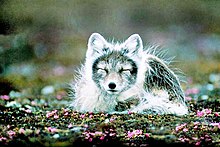User:HW+MM/sandbox
Arctic Foxes

The Arctic Fox is a small white fox that is known to inhabit the Arctic regions in the Northern hemisphere. They are usually found in Canada, Northern Asia and Europe. Although, they are not endangered, they are hunted for their fur. Due to having deep fur, they spend most of their time in the snow.

Location
[edit | edit source]Scientists believe that Arctic Foxes are found in the Arctic regions, such as: Canada, Russia, Greenland, Alaska, Iceland and Scandinavia. It is known that they build dens with multiple exits and entrances. Generally, these dens are found by a hillside or river bank.

Diet
[edit | edit source]Normally, the diet of an Artic Fox includes small mammals such as: voles, lemmings, birds and their eggs, Arctic hares, fruit, berries and dead carcasses. They also feast on ringed seal pups during April and May and fish under the surface of the ice. They have been sighted following polar bears and feeding on their leftovers. If is found that Arctic foxes are omnivores and that they have the ability to locate small animals under the snow. It is most common that they dig up the animal or jump upon the snow in order to break through.
Size and description
[edit | edit source]An average Arctic Fox measures up to 3-3.5 feet in length from head to tail and weighs 6-9 pounds. Generally speaking females are smaller than males and their fur is deep to maintain consistent body temperature. Their muzzles, ears and legs are short which also conserves heat. Arctic Foxes have many adaptions like other animals in the Tundra, such as: thick fur on their paws so they can walk on both snow and ice, a dense fur coat around its body, short ears, a small body and a large bushy tail that they use to curl around its body. They also have a rare form of fur which is white during the winter and brown during the spring.
Behavior and reproduction
[edit | edit source]The Tundra is not an easy place to inhabit since it’s barren, rocky and has very little vegetation. Arctic Foxes are extremely well adapted to their freezing homes and have secured a nice place where they can make the best out of any situation. Little is known about their behaviour and how they hunt, but they are very unique and interesting. Most have incredible hearing which is aided by their wide ears. This allows them to locate the exact position of their prey beneath the snow. Their mating season occurs during the spring and after a period of 7-8 weeks a female gives birth to an average of 6-8 kits.
Hunting Arctic Foxes
[edit | edit source]Although Arctic Foxes are not endangered they are hunted for their fur. This population has gone down over the past few years and ranges in the hundred thousands. It is cruel to think that Arctic Foxes are still on fur farms despite the fact that hunting has decreased. One would believe that these amazing species should be allowed to roam free but in reality this is far from true. They are used as game animals and some horrible people use their meat in food preparation. Although, they are not always killed by hunters but killed by a disease called rabies.

How global warming affects the Arctic Fox
[edit | edit source]The Arctic Fox is also affected by Global Warming. The melting in ice in the Arctic threatens this amazing species. They struggle as ice disappears because they rely on frozen seas to survive bad winters. Sea ice in the Arctic Tundra is formed by frozen sea water and has shrunk enormously in recent years. Arctic Foxes are not as threatened as polar bears but follow closely behind them.
As you can see, Arctic Foxes are amazing animals. It’s hard to imagine that other people can use them for their fur and meat. We have now discovered that this a truly unique species and should be kept safe for evermore.
